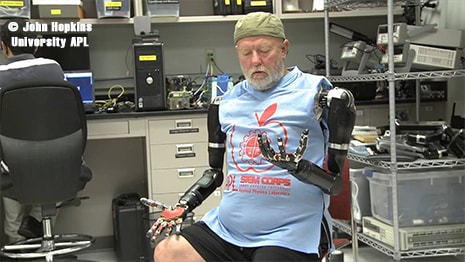Pitt-UPMC Team publishes breakthrough study where a paralyzed man is able to feel again.
Orange County, CA - October 17th 2016 - Nathan Copeland of Western Pennsylvania has been paralyzed since the age of 18. As a freshman in college, Copeland was involved in a car accident that left his neck broken and his spinal cord injured, inducing paralysis from the chest down. After the accident, Nathan enrolled himself on Pitt’s registry of patients willing to participate in an experimental procedure to improve the quality of life for those living with paralysis. A decade passes before Nathan finally receives the call.
After passing various test screenings, Nathan underwent surgery to have four tiny microelectrode arrays embedded into regions of the brain corresponding to feelings in each of his fingers, palm, and then returning to the brain. The electrodes were connected to a Brain Computer Interface (BCI), a device that enables signals from the brain to direct external activity, developed by researchers at the University of Pittsburgh and UPMC.
The BCI was then connected to the same Modular Prosthetic Limb that Johns Hopkins University’s Applied Physics Lab created, which allowed a bilateral shoulder-level amputee to grasp and move objects again. The BCI is able to make the patient feel touch by electrically stimulating the part of the brain that’s connected to their hand, which has the electrode implants. The divergence from past experimental procedures here is that the prosthetic wasn’t adhered to Copeland, but instead left free standing. Copeland was blindfolded before pressure was applied to the prosthetic and each finger was tested. For the first time in over 10 years, Nathan could feel his fingers again.

“I can feel just about every finger—it’s a really weird sensation,” Nathan Copeland said close to a month after surgery, according to UPMC. “Sometimes it feels electrical and sometimes its pressure, but for the most part, I can tell most of the fingers with definite precision. It feels like my fingers are getting touched or pushed.”
Currently, Nathan is only able to feel force and is fairly accurate in recognizing its intensity, but through mapping more of the brain and leading electrode arrays toward the limb, researchers should be able to unlock more sensations such as heat and cold.
His repeat movements and dexterity in performance while controlling the arm rivaled those of others in trials of the Modular Prosthetic Limb. The next step is to increase the dexterity to regulate the amount of force patients can use to grab or use an object.
“The ultimate goal is to create a system which moves and feels just like a natural arm would,” says Dr. Gaunt, Ph.D., assistant professor of physical medicine and rehabilitation at Pitt, according to UPMC. “We have a long way to go to get there, but this is a great start.”
Contact Ampronix:

Email: info@ampronix.com
International Sales: +1 949-273-8000
Domestic Sales: 1800-400-7972 for US and Canada
Follow Us:
Share This Article:
View our Product Catalog Online Here
About Ampronix
Ampronix is a renowned authorized master distributor of the medical industry's top brands as well as a world-class manufacturer of innovative technology. Since 1982, Ampronix has been dedicated to meeting the growing needs of the medical community with its extensive product knowledge, outstanding service, and state-of-the-art repair facility. Ampronix prides itself on its ability to offer tailored, one-stop solutions at a faster and more cost-effective rate than other manufacturers. Ampronix is an ISO & ANSI/ESD certified facility. To learn more go here.
Pitt-UPMC Team publishes breakthrough study where a paralyzed man is able to feel again. Orange County, CA – October 17th 2016 – Nathan Copeland of Western Pennsylvania has been paralyzed since the age of 18. As a freshman in college, Copeland was involved in a car accident that left his neck broken and his spinal cord injured, […]



